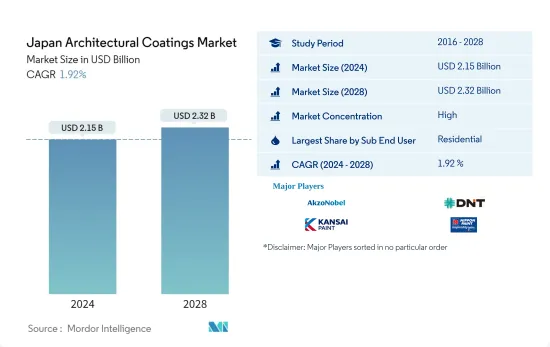 |
市场调查报告书
商品编码
1683770
日本建筑涂料:市场占有率分析、产业趋势与统计、成长预测(2025-2030 年)Japan Architectural Coatings - Market Share Analysis, Industry Trends & Statistics, Growth Forecasts (2025 - 2030) |
||||||
价格
※ 本网页内容可能与最新版本有所差异。详细情况请与我们联繫。
简介目录
日本建筑涂料市场规模预计在 2024 年为 21.5 亿美元,预计到 2028 年将达到 23.2 亿美元,预测期内(2024-2028 年)的复合年增长率为 1.92%。

主要亮点
- 最大的终端用户群:住宅:与商业占地面积相比,日本的住宅占地面积更大,因此住宅领域的建筑涂料消费量很高。
- 按技术分類的最大细分市场—水基:日本有自我规范,因此溶剂型技术的消费量高于其他地区,但按技术划分,水基技术是最大的细分市场。
- 按树脂分類的最大细分市场:丙烯酸:丙烯酸是日本的主要树脂。此外,日本的环氧树脂和聚氨酯树脂的消耗率高于其他地区。
日本建筑涂料市场的趋势
从细分终端用户来看,住宅是最大的细分市场。
- 日本建筑涂料的成长自 2016 年以来有所放缓,但预计 2020 年将再次成长。 2020 年的成长主要是受新冠疫情导致住宅维修活动增强的影响,DIY 领域销售额的成长所推动。另外,日本的住宅建筑在住宅上与世界其他住宅建筑有很大不同,因此由于日本的规格不同,油漆消费量也更高。
- 日本的住宅领域占比最高,约占80%。受此影响,儘管商业领域连续几年呈现负成长,但2016-2021年建筑涂料和涂料总消费量复合年增长率仍达2.48%。
- 在日本,住宅部门的持续需求加上人口减少和劳动力老化预计将导致预测期内商业部门的份额下降。而日本作为高度开发国家,长期遭遇通货紧缩,影响到国家整体经济成长;同样,预计 2022-2028 年期间整体建筑涂料市场将以 1.3% 的复合年增长率增长。
日本建筑涂料产业概况
日本建筑涂料市场适度整合,前五大公司占61.38%的市占率。市场的主要企业有:阿克苏诺贝尔公司、大日本涂料公司、关西涂料公司、日本涂料控股公司和SKK(S)Pte。 Ltd(按字母顺序排列)。
其他福利
- Excel 格式的市场预测 (ME) 表
- 3 个月的分析师支持
目录
第 1 章执行摘要和主要发现
第 2 章 简介
- 研究假设和市场定义
- 研究范围
- 调查方法
第三章 产业主要趋势
- 占地面积趋势
- 法律规范
- 价值链与通路分析
第 4 章 市场细分
- 次级终端用户
- 商业的
- 住宅
- 科技
- 溶剂型
- 水性
- 树脂
- 丙烯酸纤维
- 醇酸
- 环氧树脂
- 聚酯纤维
- 聚氨酯
- 其他树脂类型
第五章 竞争格局
- 重大策略倡议
- 市场占有率分析
- 业务状况
- 公司简介
- AGC Cortec Co., Ltd.
- AkzoNobel NV
- AS PAINT CO., LTD.
- BASF SE
- Chuo Paint Co., Ltd
- DAI NIPPON TORYO CO.,LTD.
- FUJIKURA KASEI CO.,LTD
- Jotun
- Kansai Paint Co.,Ltd.
- Nippon Paint Holdings Co., Ltd.
- SKK(S)Pte. Ltd
第六章 执行长的关键策略问题
第七章 附录
- 世界概况
- 概述
- 五力分析框架
- 全球价值链分析
- 市场动态(DRO)
- 资讯来源和进一步阅读
- 图片列表
- 关键见解
- 资料包
- 词彙表
简介目录
Product Code: 93089
The Japan Architectural Coatings Market size is estimated at USD 2.15 billion in 2024, and is expected to reach USD 2.32 billion by 2028, growing at a CAGR of 1.92% during the forecast period (2024-2028).

Key Highlights
- Largest Segment by End-user - Residential : Compared to commercial floor area, Japan has been observing higher volume of residential building floor area resulting in high architectural paint consumption from the residential sector.
- Largest Segment by Technology - Waterborne : Japan has Voluntary VOC requirements, hence compared to the other regions consumption of Solventborne technology is higher, though Waterborne technology is largest segment by technology.
- Largest Segment by Resin - Acrylic : Acrylic is a leading type of resin in Japan. Further, Epoxy resins and Polyurethane resins in Japan has higher percentage of consumption in comparison to other regions.
Japan Architectural Coatings Market Trends
Residential is the largest segment by Sub End User.
- The growth rate of architectural coatings in Japan has been on decline since 2016 before observing a spike back in 2020. The growth registered in 2020 is due to sales increase from the DIY segment, influenced by COVID enhanced home improvement activity. The Japanese home structures also warrants a higher paint consumption as in comparison to other housing structure around world, Japan has different specifications as their style of houses are drastically different.
- Japan's residential sector held the highest share, which oscillates around 80%. This has enabled the total architectural paint and coatings consumption to witness a CAGR of 2.48% in the period 2016-2021, even though the commercial sector has observed a few negative growth rate years in the said period.
- The commercial sector's share in Japan is expected to reduce during the forecast period, due to sustained demand in the residential segment, coupled with declining population and aging labor force. Additionally, Japan is a highly developed country coupled with country observing deflation for a prolonged period of time, this has affected the overall growth of the country, similarly, the overall architectural paints and coatings market is expected to continue but at a mere CAGR of 1.3% between the period 2022-2028.
Japan Architectural Coatings Industry Overview
The Japan Architectural Coatings Market is moderately consolidated, with the top five companies occupying 61.38%. The major players in this market are AkzoNobel N.V., DAI NIPPON TORYO CO.,LTD., Kansai Paint Co.,Ltd., Nippon Paint Holdings Co., Ltd. and SKK(S) Pte. Ltd (sorted alphabetically).
Additional Benefits:
- The market estimate (ME) sheet in Excel format
- 3 months of analyst support
TABLE OF CONTENTS
1 EXECUTIVE SUMMARY & KEY FINDINGS
2 INTRODUCTION
- 2.1 Study Assumptions & Market Definition
- 2.2 Scope of the Study
- 2.3 Research Methodology
3 KEY INDUSTRY TRENDS
- 3.1 Floor Area Trends
- 3.2 Regulatory Framework
- 3.3 Value Chain & Distribution Channel Analysis
4 MARKET SEGMENTATION
- 4.1 Sub End User
- 4.1.1 Commercial
- 4.1.2 Residential
- 4.2 Technology
- 4.2.1 Solventborne
- 4.2.2 Waterborne
- 4.3 Resin
- 4.3.1 Acrylic
- 4.3.2 Alkyd
- 4.3.3 Epoxy
- 4.3.4 Polyester
- 4.3.5 Polyurethane
- 4.3.6 Other Resin Types
5 COMPETITIVE LANDSCAPE
- 5.1 Key Strategic Moves
- 5.2 Market Share Analysis
- 5.3 Company Landscape
- 5.4 Company Profiles
- 5.4.1 AGC Cortec Co., Ltd.
- 5.4.2 AkzoNobel N.V.
- 5.4.3 AS PAINT CO., LTD.
- 5.4.4 BASF SE
- 5.4.5 Chuo Paint Co., Ltd
- 5.4.6 DAI NIPPON TORYO CO.,LTD.
- 5.4.7 FUJIKURA KASEI CO.,LTD
- 5.4.8 Jotun
- 5.4.9 Kansai Paint Co.,Ltd.
- 5.4.10 Nippon Paint Holdings Co., Ltd.
- 5.4.11 SKK(S) Pte. Ltd
6 KEY STRATEGIC QUESTIONS FOR ARCHITECTURAL COATINGS CEOS
7 APPENDIX
- 7.1 Global Overview
- 7.1.1 Overview
- 7.1.2 Porter's Five Forces Framework
- 7.1.3 Global Value Chain Analysis
- 7.1.4 Market Dynamics (DROs)
- 7.2 Sources & References
- 7.3 List of Tables & Figures
- 7.4 Primary Insights
- 7.5 Data Pack
- 7.6 Glossary of Terms
02-2729-4219
+886-2-2729-4219









